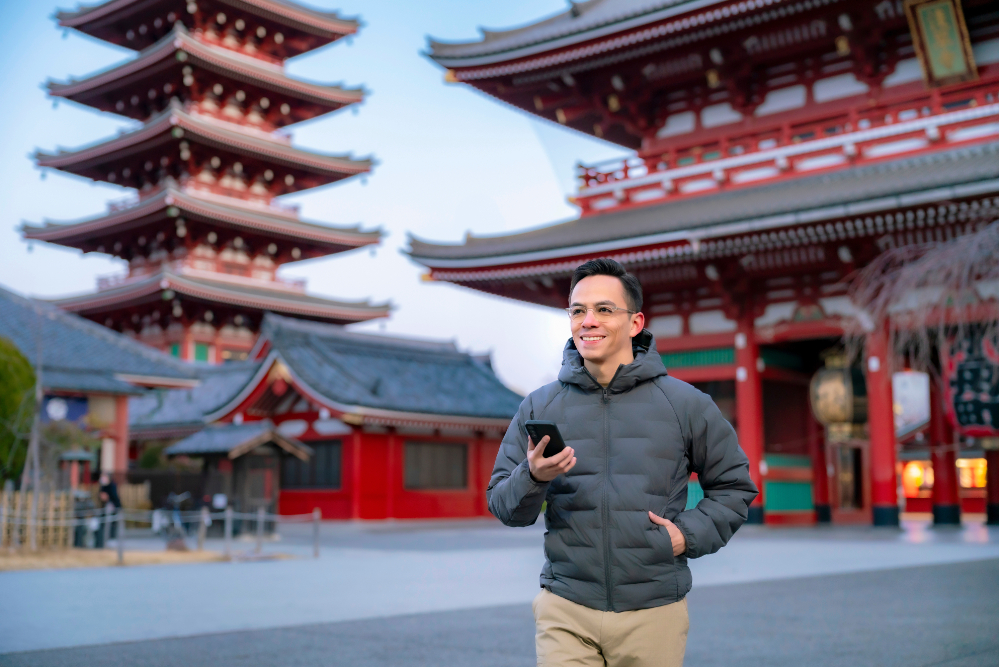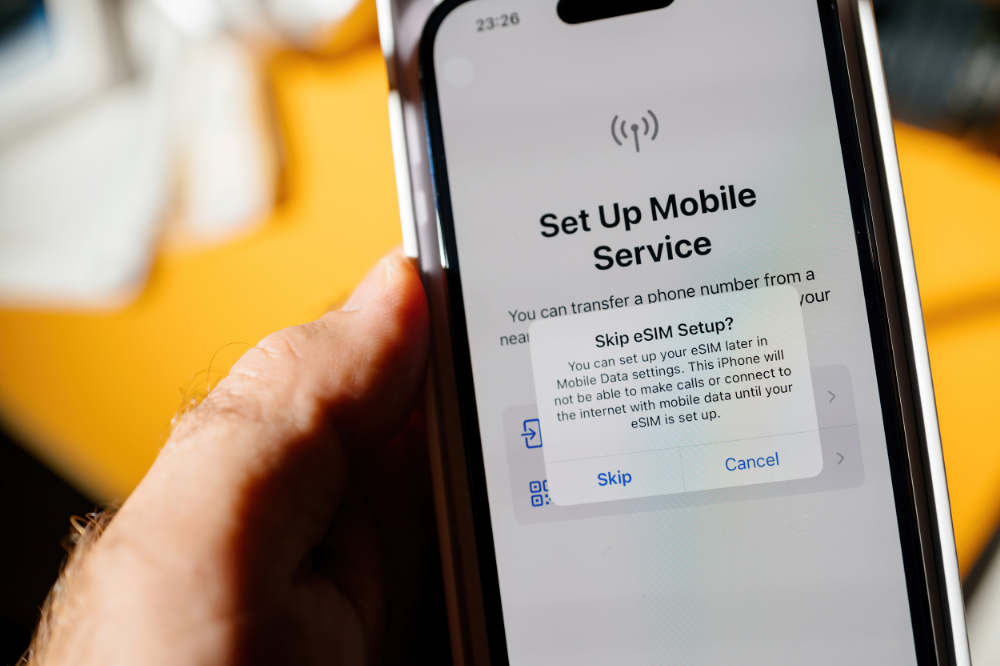The Ultimate Guide to Using an eSIM on Your iPhone in Japan: What Travelers Need to Know

Landing in Japan without a mobile data plan can quickly become frustrating. From finding your hotel to translating signs or sharing photos, reliable internet isn’t just convenient—it’s essential. Yet, free WiFi is rare, and roaming fees can add up quickly.
If you’re an iPhone user, there’s a more innovative solution: the eSIM. Built into newer iPhone models, it lets you activate mobile service in Japan without swapping out your SIM card. Quick to set up and easy to manage, it keeps you connected wherever you go.
This guide explains how to use an eSIM on your iPhone in Japan, compares it to SIM cards and pocket WiFi, and outlines what to consider before choosing the best option for your trip.
Why You Need an eSIM or SIM Card for Your iPhone in Japan
Whether you’re in Tokyo or Hokkaido, staying connected in Japan can be unexpectedly difficult for foreign travelers.
Without proper planning, iPhone users may encounter compatibility issues or limited access to a dependable internet connection.
Challenges with Mobile Data Access in Japan
Free WiFi is not as widely available in Japan as many travelers assume. While some hotels, cafés, and convenience stores offer access, connections are often unstable, slow, or require time-consuming registration.
Lack of consistent data access makes it more challenging to utilize essential tools like Google Maps and Google Lens for navigation and translation, as well as WhatsApp and Messenger for real-time messaging.
Navigating public transportation while being outside or coordinating plans with friends and family can quickly become a challenge when service is unreliable.
Benefits of Using an eSIM or SIM for Your iPhone
Booking an eSIM or SIM card ahead of time provides immediate access to mobile data upon arrival in Japan.
There's no need to waste time relying on spotty airport WiFi or searching for a mobile shop after a long flight.
Both options offer flexibility for short-term visitors or long-term residents, with data plans tailored to different usage levels, from light browsing to heavy streaming.
eSIM for Japan iPhone Users: What it is and How it Works

For travelers using an iPhone in Japan, choosing an eSIM is often the most efficient way to access mobile data without relying on local SIM cards or limited WiFi hotspots.
Understanding how an eSIM works and setting it up correctly can help avoid connectivity issues from the start of your trip.
What is an eSIM and How Does it Work on an iPhone?
An eSIM (embedded SIM) is a digital alternative to the traditional physical SIM card. Instead of inserting a card into your device, your iPhone stores the SIM information internally and connects to mobile networks through a digital profile.
Apple introduced eSIM support starting with the iPhone XR, XS, and XS Max. All later models, including the iPhone 11, 12, 13, 14, and 15 series, also support eSIM. Most models support dual SIM functionality, allowing travelers to keep their home number active while using a local data plan via eSIM.
The eSIM setup process is handled through the iPhone’s settings and does not require visiting a physical store or opening the SIM tray.
Setting Up Your iPhone eSIM
Setting up an eSIM on an iPhone is a secure and straightforward process.
After purchasing a plan from a provider that supports eSIM, most users receive a QR code via email or can access the installation through a mobile app. Scanning the QR code or following in-app instructions allows the eSIM profile to be downloaded directly to the device.
Activation is managed through the iPhone’s Settings menu under Cellular or Mobile Data. Once the eSIM appears, users can assign a label (such as "Japan Data") and choose how the plan is used.
For any dual-SIM use, the iPhone must be carrier-unlocked; otherwise, eSIM installation may not be possible with a non-domestic plan.
Connecting to WiFi is usually required during activation, since your device won’t have mobile service until the eSIM is fully set up.
Best eSIM for iPhone
When comparing eSIM options for iPhone users in Japan, consider several key factors:
- ●Network coverage across urban and rural areas
- ●Daily or total data limits
- ●Compatibility with your iPhone model
- ●Responsive customer service in English
-
Some travelers prefer to combine an eSIM with a portable WiFi device to ensure continuous coverage, especially in remote areas or for group use.
NINJA WiFi’s pocket WiFi plans start at 440 yen per day for 1GB of high-speed data, with no restrictions on data usage otherwise, and range up to 2,200 yen per day for Unlimited 5G data.
Meanwhile, NINJA WiFi’s eSIM plans start at 3,102 yen for 5 days with 5GB of data, offering many flexible options, such as 20GB of data for 15 days at 6,204 yen or 50GB of data for 21 days at 12,199 yen. -
SIM Cards vs eSIM for iPhone Users in Japan: Which is Better ?

If you plan to use your iPhone in Japan, you may still be weighing the choice between a physical SIM card and an eSIM.
Let’s see how each works in Japan and determine which one is more suitable, considering your device and travel needs.
How a Physical SIM Card Works on an iPhone
Many iPhones, especially those released before 2018, rely on a physical SIM card inserted into the device’s SIM slot. For newer models, Apple supports both physical SIMs and eSIMs, allowing for dual SIM functionality.
However, note that some newer models, particularly in the US, are transitioning to eSIM-only. Specifically, iPhones, such as the 14 series and later, purchased in the US, do not have a physical SIM tray and only support eSIMs.
Luckily, having an eSIM-only iPhone does not limit dual SIM functionality; travelers will simply need to make sure that they book an eSIM for their trip, thereby benefiting from dual eSIM functionality.
For most iPhone users, however, using a physical SIM card in Japan is a viable option. It typically involves:
- ●A compatible iPhone with an unlocked SIM slot
- ●Manual configuration of APN (Access Point Name) settings to enable mobile data
- ●In some cases, restarting the device after inserting the SIM allows the network to be detected
-
While straightforward, using a physical SIM card can be less convenient than eSIM, especially for travelers unfamiliar with manual configuration steps.
-
Pros and Cons: SIM Card vs eSIM in Japan
-
eSIM
- Enables immediate activation without waiting for shipping or store visits
- No physical card needed—simply scan a QR code or download the carrier profile
- Allows multiple profiles on a single device (ideal for frequent travelers or business users)
-
Physical SIM Card
- ●Familiar setup for users accustomed to traditional mobile service
- ●Ideal for those using older iPhones without eSIM support
- ●Requires physically swapping SIMs, which can be less convenient when traveling
-
For tech-savvy users with compatible iPhones, eSIM offers a faster setup process, especially when arranged in advance of arrival in Japan.
On the other hand, travelers who prefer the feel and process of using a physical SIM card may still find it a reliable solution, albeit with a few more manual steps. -
Practical Tips for Using an eSIM or SIM Card in Japan

Whether visiting for a few days or staying longer, knowing how to make the most of your iPhone’s mobile connectivity can help avoid unnecessary stress.
The following tips provide essential information, address common issues, and offer wise choices for staying connected during your time in Japan.-
Can You Tether With an eSIM or SIM Card in Japan ?
-
Yes, both eSIM and physical SIM cards typically support tethering in Japan. Most major Japanese carriers allow the use of personal hotspots, enabling you to share your mobile data connection with other devices.
Sharing data with several people is especially useful when traveling with family or colleagues.
-
Is it Better to Use Roaming, eSIM, SIM, or Pocket WiFi ?
-
The best option depends on your travel needs:
- ●Using an eSIM is often the most efficient and hassle-free solution for short visits. Activation is instant, and there is no need to handle physical hardware.
- ●Renting a pocket WiFi device can be more cost-effective for more extended stays or when traveling as a group. It offers unlimited data, supports multiple devices, and can be picked up directly at the airport or delivered to your accommodation.
- ●Traditional SIM cards are still valid for those with older devices or a strong preference for physical cards.
- ●Roaming tends to be the most expensive choice and is generally not recommended unless you have a specific international plan with favorable rates.
Conclusion
Staying connected in Japan begins with selecting the mobile option that best suits your travel style and device.
For most iPhone users, eSIMs offer a modern solution, particularly convenient for short-term stays or solo travelers who want immediate access to data without any supplementary hardware.
Before your trip, take a moment to compare your options.
Whether you choose a local SIM card, an eSIM, or a pocket WiFi, selecting the proper setup ensures a smoother and more connected experience throughout your time in Japan.
Get started now and travel confidently, knowing your iPhone is ready to go the moment you land.








